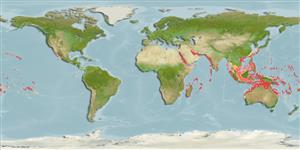Common names from other countries
>
Eupercaria/misc (Various families in series Eupercaria) >
Labridae (Wrasses) > Bodianinae
Etymology: Bodianus: Bodianus after Bodiano or Pudiano, from the Portuguese pudor, meaning modesty (Jordan & Evermann, 1896).; anthioides: Name from the Greek masculine noun 'anthias', a common name for members of the anthiine serranid fishes, and 'oides' for having the form of, refers to the similarity of this species to various anthiine species (Ref. 75973).
More on author: Bennett.
Environment: milieu / climate zone / depth range / distribution range
Ecología
marino asociado a arrecife; rango de profundidad 6 - 80 m (Ref. 1602), usually 6 - 60 m (Ref. 27115). Tropical; 23°C - 27°C (Ref. 27115); 32°N - 28°S
Indo-Pacific: Red Sea to South Africa (Ref. 35918) and east to the Line and Tuamoto islands, north to southern Japan, south to New Caledonia and the Austral Islands.
Tamaño / Peso / Age
Maturity: Lm ? range ? - ? cm
Max length : 24.0 cm SL macho / no sexado; (Ref. 1602)
Espinas dorsales (total) : 12; Radios blandos dorsales (total) : 9 - 10; Espinas anales: 3; Radios blandos anales: 10 - 12. Undergoes relatively minor changes in color with growth. Easily identified by the unusual coloration and long tail (Ref. 48636).
Adults inhabit seaward reefs. They occur on reefs rich with invertebrates such as gorgonians, seawhips and black corals (Ref. 48636). Common along steep outer reef slopes deeper than 25 m in Micronesia. Usually seen as lone individuals (Ref. 48636). Juveniles pose as cleaners (Ref. 8631). May be solitary or may exist in pairs (Ref. 5503). Oviparous, distinct pairing during breeding (Ref. 205). Maximum depth reported taken from Ref. 128797.
Life cycle and mating behavior
Maturities | Reproducción | Spawnings | Egg(s) | Fecundities | Larva
Oviparous, distinct pairing during breeding (Ref. 205).
Gomon, M.F., 2006. A revision of the labrid fish genus Bodianus with descriptions of eight new species. Rec. Aust. Mus. Suppl. 30:1-133. (Ref. 75973)
IUCN Red List Status (Ref. 130435)
CITES (Ref. 128078)
Not Evaluated
Threat to humans
Harmless
Human uses
Pesquerías: comercial; Acuario: Comercial
Herramientas
Special reports
Download XML
Fuentes de Internet
Estimates based on models
Preferred temperature (Ref.
115969): 24.4 - 28.9, mean 27.6 (based on 1138 cells).
Phylogenetic diversity index (Ref.
82804): PD
50 = 0.5000 [Uniqueness, from 0.5 = low to 2.0 = high].
Bayesian length-weight: a=0.01202 (0.00551 - 0.02625), b=3.05 (2.87 - 3.23), in cm Total Length, based on LWR estimates for this Genus-body shape (Ref.
93245).
Nivel trófico (Ref.
69278): 3.4 ±0.44 se; based on food items.
Resiliencia (Ref.
120179): Medio, población duplicada en un tiempo mínimo de 1.4-4.4 años (Preliminary K or Fecundity.).
Fishing Vulnerability (Ref.
59153): Low vulnerability (19 of 100).
